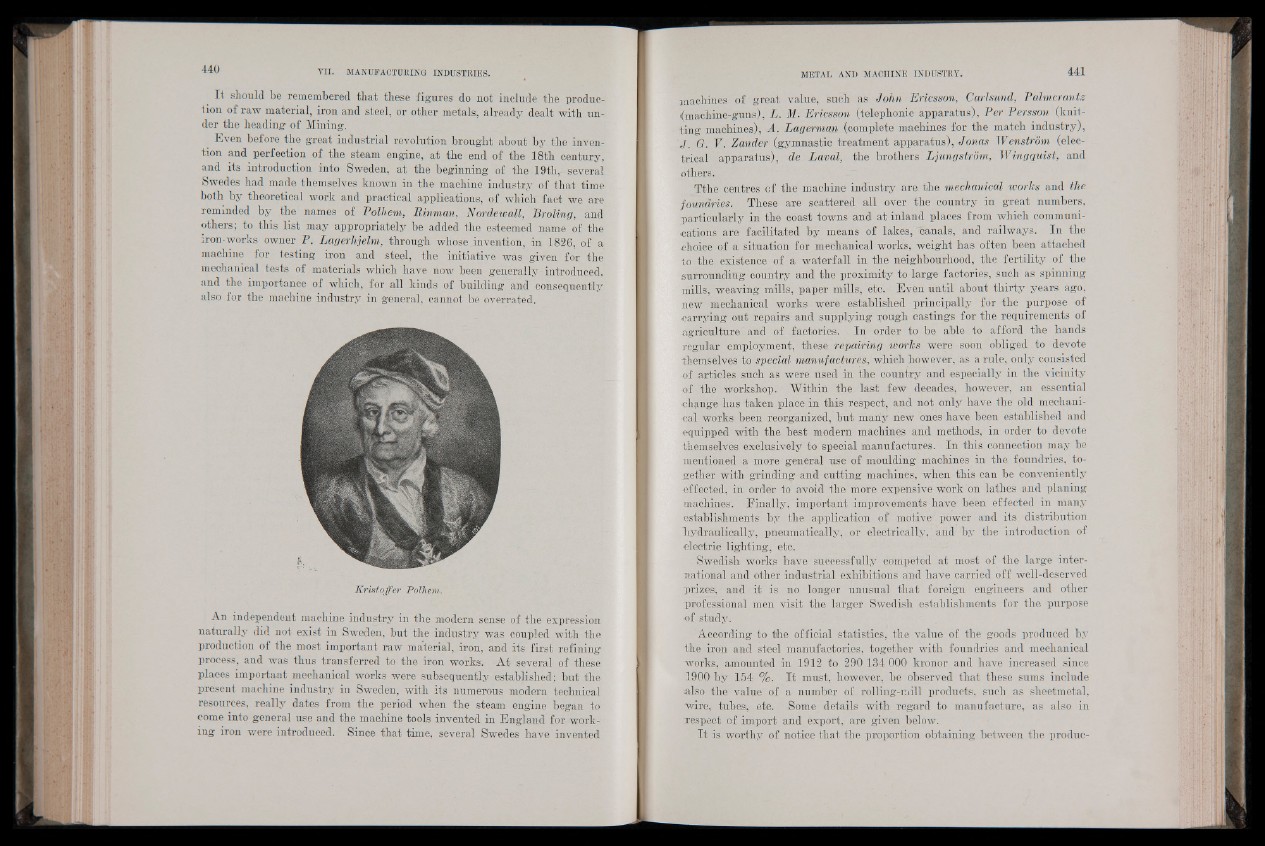
It should be remembered that these figures do not include the production
of raw material, iron and steel, or other metals, already dealt with under
the heading of Mining.
Even before the great industrial revolution brought about by the invention
and perfection of the steam engine, at the end of the 18th century,
and its introduction into Sweden, at the beginning of the 19th, several
Swedes had made themselves known in the machine industry of that time
both by theoretical work and practical applications, of which fact we are
reminded by the names of Polhem, Rinman, Nordewall, Broiing, and
others; to this list may appropriately be added the esteemed name of the
iron-works owner P. Lagerhjelm, through whose invention, in 1826, of a
machine for testing iron and steel, the initiative was given for the
mechanical tests of materials which have now been generally-introduced,
and the importance of which, for all kinds of building and consequently
also fo.r the machine industry in general, cannot be overrated.
Kristoffer Polhem.
An independent machine industry in the modern sense of the expression
naturally did not exist in Sweden, but the industry was coupled with the
production of the most important raw material, iron, and its first refining
process, and was thus transferred to the iron works. At several of these
places important mechanical works were subsequently established; but the
present machine industry in Sweden, with its numerous modern technical
resources, really dates from the period when the steaim engine began to
come into general use and the machine tools invented in England for working
iron were introduced. Since that time, several Swedes have invented
machines of great value, such as John Ericsson, Carlsund, Palmcrantz
(machine-guns), L. M. Ericsson (telephonic apparatus), Per Persson (knitting
machines), A. Lagerman_ (complete machines for the match industry),
J. G. V. Zander (gymnastic treatment apparatus), Jonas Wenstrôm (electrical:
apparatus), de Laval, the brothers Ljungstrom, Wingquist, and
others.
Tthe centres of the machine industry are the mechanical works and the
foundries. These are scattered all over the country in great numbers,
particularly in the coast towns and at inland places from which communications
are facilitated by means of lakes, canals, and railways. In the
choice of a situation for mechanical works, weight has often been attached
to the existence of a waterfall in the neighbourhood, the fertility of the
surrounding country and the proximity to large factories, such as spinning
mills, weaving mills, paper mills, etc. Even until about thirty years ago,
new mechanical works were established principally for the purpose of
carrying out repairs and supplying rough castings for the requirements of
agriculture and of factories. In order to be able to afford the hands
regular employment, these repairing works were soon obliged to devote
themselves to special manufactures, which however, as a rule, only consisted
■of articles such as were used in the country and especial^ in the vicinity
•of the workshop. Within the last few decades, however, an essential
change has taken place in this respect, and not only have the old mechanical
works been reorganized, but many new ones have been established and
equipped with the best modern machines and methods, in order to devote
themselves exclusively to special manufactures. In this connection may be
mentioned a more general use of moulding machines in the foundries, together
with grinding and cutting machines, when this can be conveniently
effected, in order to avoid the more expensive work on lathes and planing
machines. Finally, important improvements have been effected in many
establishments by the application of motive power and its distribution
liydraulically, pneumatically, or electrically, and by the introduction of
electric lighting, etc.
Swedish works have successfully competed at most of the large international
and other industrial exhibitions and have carried off well-deserved
prizes, and it is no longer unusual that foreign engineers and other
professional men visit the larger Swedish establishments for the purpose
•of study.
According to the official statistics, the value of the goods produced by
the iron and steel manufactories, together with foundries and mechanical
works, amounted in 1912 to 290 134 000 kronor and have increased since
1900 by 154 %. It must, however, be observed that these sums include
also the value of a number of rolling-mill products, such as sheetmetal,
wire, tubes, etc. Some details with regard to manufacture, as also in
lespect of import and export, are given below.
It is worthy of notice that the proportion obtaining between the produc